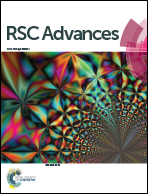Synthesis of novel 1,5-disubstituted pyrrolo[1,2-a]quinazolines and their evaluation for anti-bacterial and anti-oxidant activities†
Abstract
A new series of 1,5-disubstituted pyrrolo[1,2-a]quinazoline derivatives were prepared from 2-chloro-4-substituted quinazolines, propargyl alcohol, and secondary amines through novel multi-component reactions. These one-pot reactions, carried out in the presence of a palladium-copper catalyst, provide an efficient method for the synthesis of functionalized pyrrolo[1,2-a]quinazolines in good-to-high yields. A number of synthesized compounds were screened for their in vitro anti-bacterial activity against Gram-positive and Gram-negative bacteria using a well-diffusion method. Also the anti-oxidant activity of the products was evaluated using the DPPH (2,2-diphenyl-2-picrylhydrazyl) assays.
![Graphical abstract: Synthesis of novel 1,5-disubstituted pyrrolo[1,2-a]quinazolines and their evaluation for anti-bacterial and anti-oxidant activities](/en/Image/Get?imageInfo.ImageType=GA&imageInfo.ImageIdentifier.ManuscriptID=C6RA21219K&imageInfo.ImageIdentifier.Year=2016)

 Please wait while we load your content...
Please wait while we load your content...